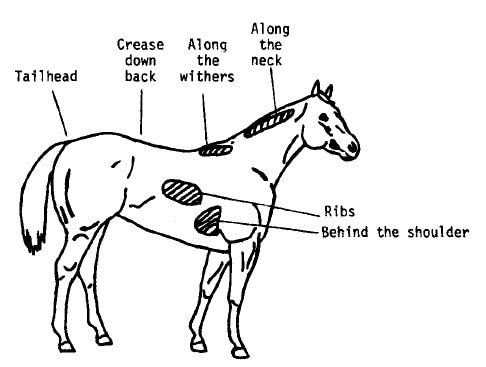Using the Horse Body Condition Scoring System
By: Dr. Lydia Gray
Being able to follow trends in your horse’s body weight is important in tracking his overall health. One method is to estimate his actual weight by using a commercially available weight tape or by calculating his body weight from the heart girth and length formula (click here to have us do the calculation for you!) However, it is just as important to regularly assess your horse’s body condition score, or his amount of fat cover.
An excellent tool for making this assessment is the Henneke Horse Body Condition Scoring System, because it provides a standard scale for you, your veterinarian, your equine nutritionist, and other health care professionals to use and compare. The scale ranges from a 1, which is the thinnest, to a 9, which is the fattest—a score of 5 is ideal for most breeds and disciplines.
There are six areas on the horse’s body where the degree of fat in relation to muscle is assessed. These are the neck, the area behind the shoulder, the withers, the ribs, the loin, and the tailhead. When evaluating the level of fat in each of these locations it is important to feel its thickness with your hands as well as to visualize it, because looks can be deceiving! Using the descriptive chart below, assign a numerical value to each area then average them to come up with your horse’s Henneke body condition score.

1 – Poor
Animal extremely emaciated. Spinous processes, ribs, tailhead, and tuber coxae and ischia projecting prominently. Bone structure of withers, shoulders and neck easily noticeable. No fatty tissue can be felt.
2 – Very thin
Animal emaciated. Slight fat covering over base of spinous processes, transverse processes of lumbar spinous processes feel rounded. Spinous processes, ribs, tailhead, tuber coxae and ischii prominent. Withers, shoulders and neck structures faintly discernible.
3 – Thin
Fat buildup about halfway on spinous processes, transverse processes cannot be felt. Slight fat coverover ribs. Spinous processes and ribs easily discernible. Tailhead prominent, but individual spinous processes cannot be visually identified. Tuber coxae appear rounded, but easily discernible. Tuber ischii not distinguishable. Withers, shoulders and neck accentuated.
4 – Moderately thin
Negative crease along back. Faint outline of ribs discernible. Tailhead prominence depends on conformation, fat can be felt around it. Tuber coxae not discernible. Withers, shoulders and neck not obviously thin.
5 – Moderate
Back level. Ribs cannot be visually distinguished but can be easily felt. Fat around tailhead beginning to feel spongy. Withers appear rounded over spinous processes. Shoulders and neck blend smoothly into body.
6 – Moderately fleshy
May have slight crease down back. Fat over ribs feels spongy. Fat around tailhead feels soft. Fat beginning to be deposited along the side of the withers, behind the shoulders, and along the sides of the neck.
7 – Fleshy
May have crease down back. Individual ribs can be felt, but noticeable filling between ribs with fat. Fat around tailhead is soft. Fat deposited along withers, behind shoulders and along the neck.
8 – Fat
Crease down back. Difficult to feel ribs. Fat around tailhead very soft. Area along withers filled with fat. Area behind shoulder filled with fat. Noticeable thickening of neck. Fat deposited along inner thighs.
9 – Extremely fat
Obvious crease down back. Patchy fat appearing over ribs. Bulging fat around tailhead, along withers, behind shoulders and along neck. Fat along inner thighs may rub together. Flank filled with fat.
Henneke DR, Potter GD, Kreider JL, Yeates BF. Relationship between condition score, physical measurements and body fat percentage in mares. Equine Vet J. 1983 Oct;15(4):371-2.Improve your ability to horse body condition score by evaluating as many different horses as possible, assessing the six areas in the same order each time so that you develop a system. You’ll find that in some disciplines, like racing, and some life stages, like pregnancy, a higher or lower score than the moderate 5 might be preferred. Also, some extremes in conformation (such as very high withers or a swayback) can make evaluating the degree of fat cover over a certain area challenging. In these cases, you may have to throw out one or two of the six scores before averaging the rest to come up with a single numerical value. And because some horses didn’t read the book, it’s okay to record an in-between value like 4.5 or 6.5 using half points.
SmartPak strongly encourages you to consult your veterinarian regarding specific questions about your horse's health. This information is not intended to diagnose or treat any disease, and is purely educational.